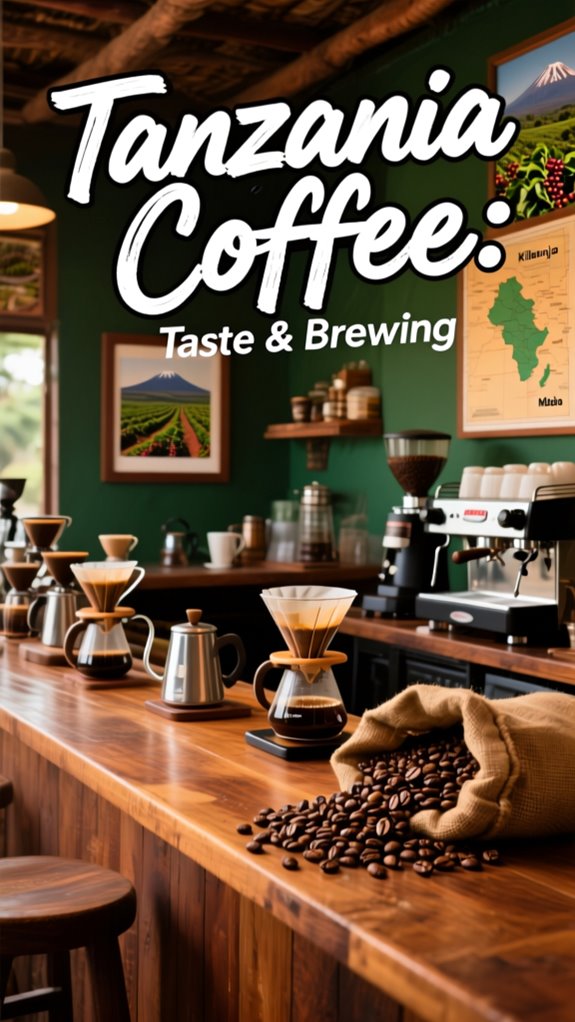Ever wonder why some coffee professionals rave about Tanzanian beans while most grocery store shelves barely feature them? You’re not alone. Tanzania produces some of the world’s most distinctive coffees, yet they remain surprisingly under-the-radar for many home brewers.
This guide breaks down everything you need to know about Tanzania coffee—from the unique flavor profiles you can expect, to the key growing regions that produce these exceptional beans, to the best brewing methods for bringing out their bright, fruity characteristics. Whether you’re a curious beginner or a seasoned coffee enthusiast looking to expand your palate, you’ll discover why these East African beans deserve a permanent spot in your rotation.
Table of Contents
What makes Tanzania coffee beans so special
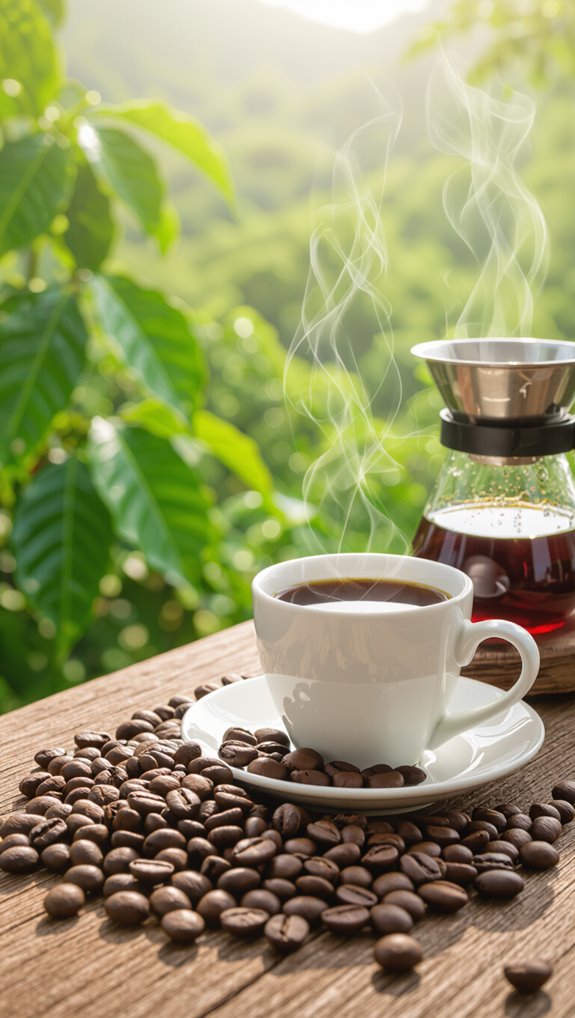
Tanzania’s coffee beans are a treasure trove of flavor, standing out in the global coffee landscape due to their exceptional genetic diversity and extraordinary growing conditions. Small-scale farmers play a crucial role in preserving the traditional cultivation methods that contribute to the beans’ unique quality.
From the volcanic slopes of Kilimanjaro to high-altitude regions, these beans develop unique characteristics that set them apart. Peaberry mutations concentrate intense flavors, while varieties like Arabica and Robusta offer remarkable taste profiles.
The volcanic soil, coupled with precise wet processing and expert roasting techniques, transforms these beans into liquid gold.
Each region—Kilimanjaro, Southern Highlands, and West Lakes—contributes its own distinctive flavor signature, making Tanzanian coffee a truly remarkable experience.
Tanzania coffee taste and flavor profile
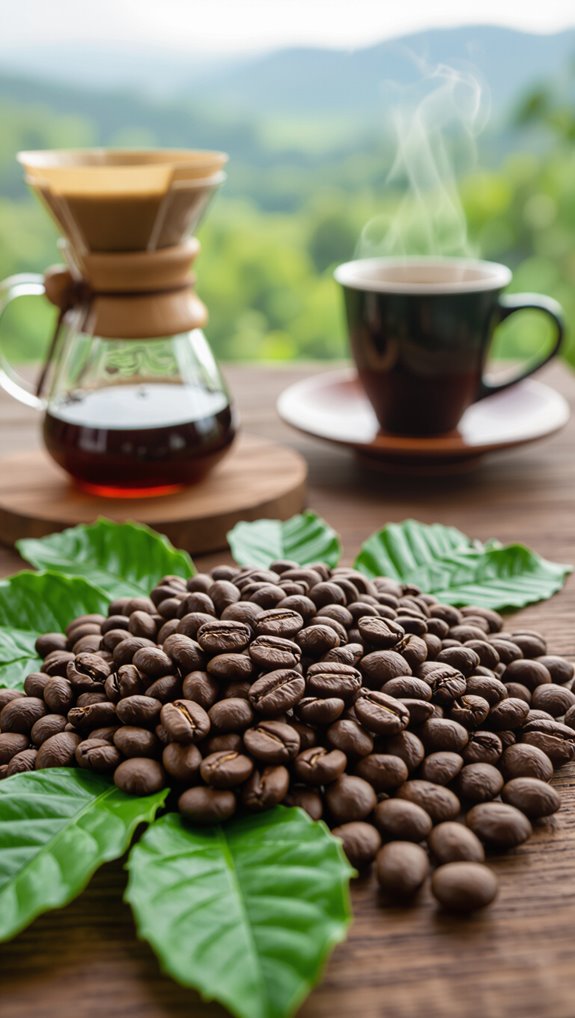
The liquid magic of Tanzanian coffee unfolds through a captivating flavor symphony that dances between bright, fruity notes and rich, smooth undertones.
This remarkable coffee offers a sensory journey with:
- Black cherry and citrus hints
- Chocolate and molasses depths
- Wine-like acidity
- Silky smooth body
- Wildly complex tropical undertones
Each sip reveals layers of complexity, from the high-altitude regions like Kilimanjaro to the Southern Highlands.
The clean processing and volcanic soils contribute to a balanced, clean profile that shifts beautifully between medium and dark roasts.
High-altitude volcanic soils in regions like Kilimanjaro create a unique microclimate that concentrates nutrients and develops more nuanced flavor profiles.
Whether you’re brewing with a Chemex or French press, Tanzanian coffee promises an extraordinary taste adventure that’ll transform your coffee experience.
Top coffee growing regions in Mount Kilimanjaro
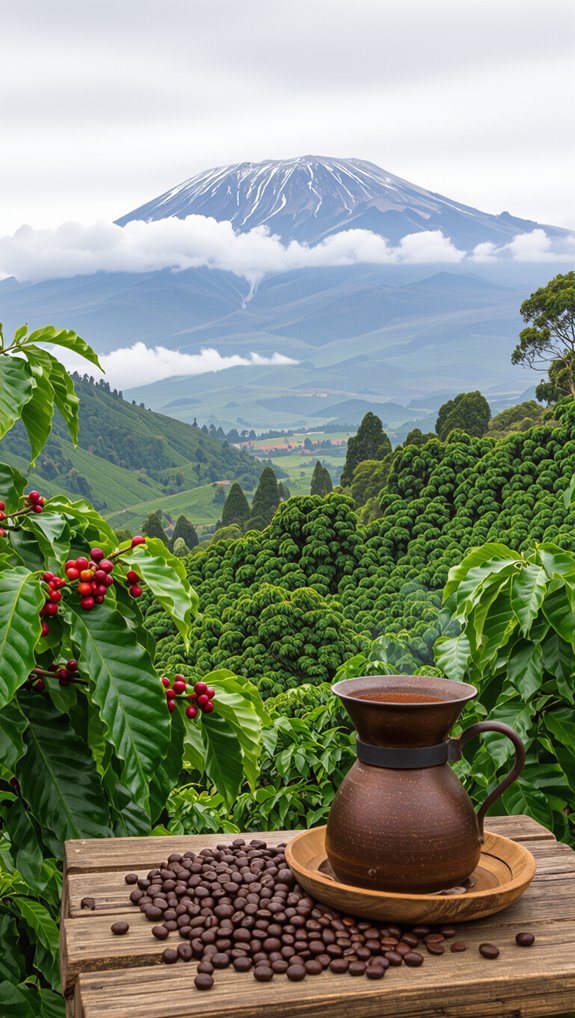
Nestled around the majestic Mount Kilimanjaro, the coffee-growing regions of Moshi and Arusha represent a paradise for coffee enthusiasts seeking exceptional Arabica beans.
These slopes cradle over 1 million residents whose livelihoods depend on coffee cultivation, with farms situated between 1,400-1,800 meters above sea level.
The volcanic, nutrient-dense soil and shaded microclimates create perfect conditions for growing Strictly High Grown (SHG) coffee.
Varieties like Kent, Bourbon, and the renowned Chagga AA peaberry thrive here, producing beans with distinctive flavor notes of tangerine, caramel, and chocolate.
Export earnings contribute significantly to Tanzania’s agricultural economy, with coffee comprising approximately 20% of the nation’s total export value.
Tanzanian peaberry coffee vs regular beans today
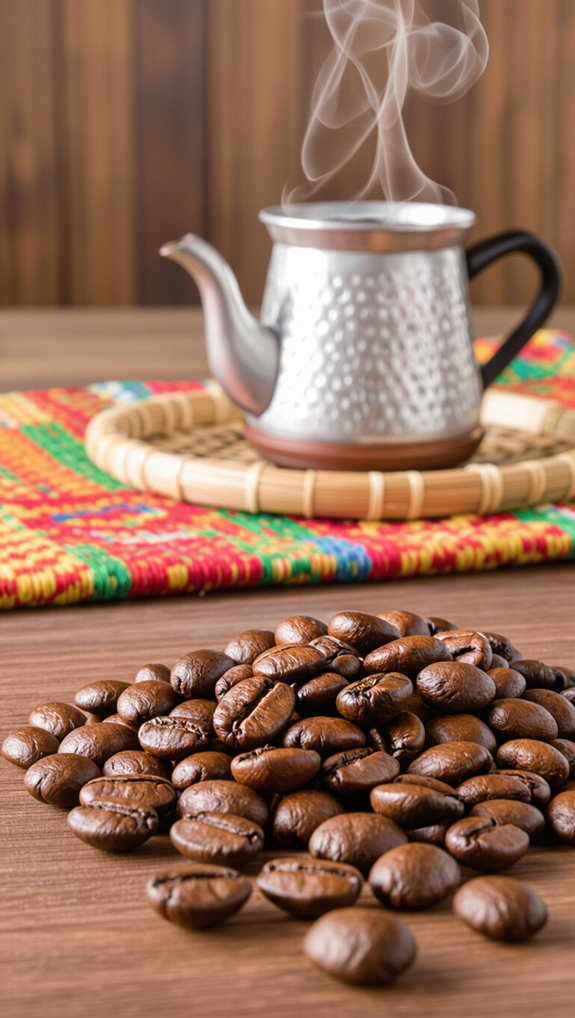
Dive into the world of Tanzanian coffee, and you’ll quickly discover the intriguing battle between peaberry and regular beans – a difference that can make or break your morning brew.
- Peaberries are rare, making up just 4-10% of coffee harvests
- They’re smaller, rounder, and often more flavorful than regular beans
- Roasting requires special attention due to their unique density
- Typically command a $10-15 premium per pound
- Offer a sweeter, more concentrated flavor profile
These unique beans represent more than just a coffee variation – they’re a testament to the nuanced world of specialty coffee, where every detail matters in crafting the perfect cup.
How to brew Tanzania coffee at home

I’ll brew a perfect cup of Tanzanian coffee at home by carefully selecting the right grind size, water temperature, and brewing equipment to highlight these beans’ unique flavor profile. My go-to methods include pour-over and Aeropress, which let me control extraction and showcase the coffee’s bright, fruity characteristics.
I’ll walk you through each step, from choosing the right grinder to mastering water-to-coffee ratios, so you can experience the vibrant taste of Tanzania in your own kitchen.
Best grind size and equipment
Unlock the full potential of Tanzania’s exceptional coffee by mastering the right grind size and brewing equipment for your favorite method.
Key considerations for brewing Tanzania coffee include:
- Choose a burr grinder for consistent, uniform particle sizes
- Match grind size precisely to your brewing method (coarse for French press, fine for espresso)
- Grind beans immediately before brewing to preserve aromatic qualities
- Experiment with slight grind adjustments to fine-tune flavor profile
- Clean your grinding equipment regularly to prevent flavor contamination
The right equipment transforms Tanzania’s delicate, floral beans into a remarkable cup, highlighting their unique regional characteristics with each carefully crafted brew.
Water temperature and brew ratios
Brewing exceptional Tanzanian coffee at home hinges on mastering two critical variables: water temperature and brew ratios.
The sweet spot for water temperature ranges between 90°C and 98°C, depending on your coffee’s processing and roast level. Washed coffees shine around 94°C–98°C, while natural processed beans prefer slightly cooler temperatures.
Brew ratios from 1:15 to 1:18 (coffee to water) let you customize your cup’s intensity. Lower ratios create a stronger, fuller-bodied brew, while higher ratios yield a lighter, brighter experience with more pronounced acidity. Experiment to find your perfect balance and unlock Tanzania’s complex fruity and winey flavor profile.
Step by step brewing instructions
Now that we’ve dialed in water temperature and brew ratios, let’s walk through the step-by-step process of brewing spectacular Tanzanian coffee at home.
Master the art with these key techniques:
- Select freshly roasted Tanzanian beans
- Grind to method-specific consistency (medium-coarse for French press, fine for espresso)
- Use filtered water heated to 90-96°C
- Bloom coffee grounds by initial wetting to release CO2
- Pour water slowly in circular motions, maintaining even saturation
Each brewing method—pour-over, French press, or Aeropress—will unlock the unique fruity, floral, and winey characteristics of Tanzanian coffee, transforming your morning ritual into a sensory experience.
Best ways to buy quality Tanzania coffee

Navigating the world of Tanzanian coffee requires comprehension of key quality markers and strategic purchasing approaches to ensure you’re getting the most exceptional beans.
Look for specialty retailers offering transparent sourcing with clear roast dates, focusing on specific regional labels like Kilimanjaro or Mbeya. Prioritize beans from recent harvests (December–July), avoiding generic supermarket offerings. Key indicators of quality include uniform bean size, minimal defects, and certifications like organic or Fair Trade. Online specialty coffee subscriptions often provide the widest selection of microlots, allowing you to explore Tanzania’s rich coffee landscape with confidence.
Tanzania coffee culture and historical traditions
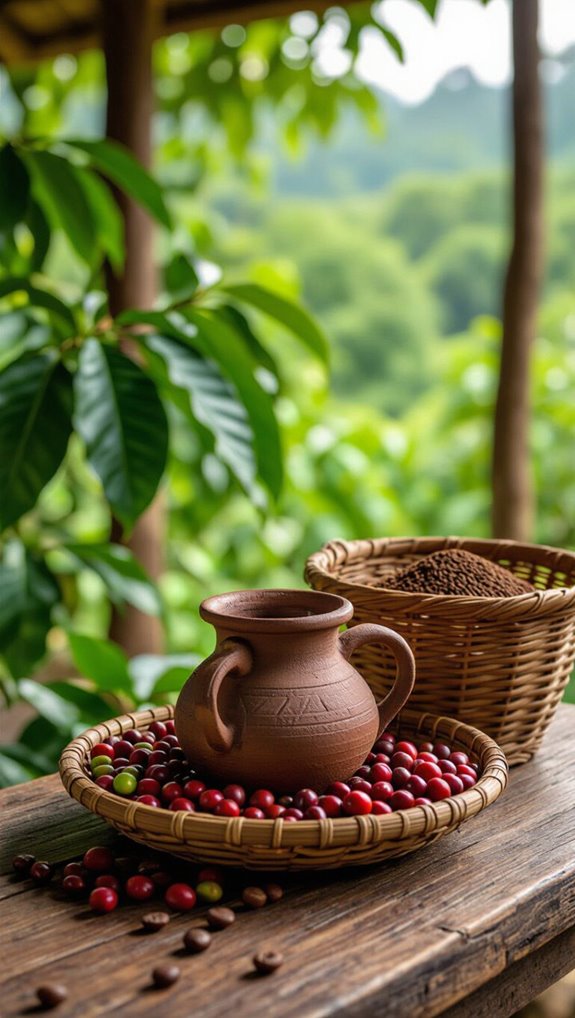
Tanzania’s coffee culture weaves a rich tapestry of historical traditions that extend far beyond simple beverage consumption, revealing a profound narrative of cultural resilience and agricultural heritage. Coffee isn’t just a drink here—it’s a living story of community, ritual, and survival.
Key elements of Tanzania’s coffee traditions include:
- Cultural ceremonies using coffee as a sacred ritual
- Community gatherings that strengthen social bonds
- Religious practices integrating coffee symbolically
- Hospitality expressed through elaborate coffee serving
- Historical connections tracing back to indigenous tribes
From the Haya tribe‘s early smoking of coffee cherries to modern cooperative farming, Tanzania’s coffee journey reflects deep cultural pride and resilience.
How to make cold brew with Tanzania beans

If you’re eager to craft a smooth, chocolatey cold brew using Tanzania beans, you’ll need just a few key ingredients: coarse-ground Tanzanian coffee, cold water, and some basic brewing equipment like a French press or mason jar.
I recommend starting with a coffee-to-water ratio between 1:8 and 1:10 by weight, which will help you extract those signature berry and chocolate notes without overwhelming bitterness.
To begin, you’ll grind your beans coarsely, combine them with cold water, and let the mixture steep in the refrigerator for 12-14 hours, ensuring a rich, nuanced cold brew that showcases the unique flavor profile of Tanzania’s exceptional coffee.
Ingredients needed
Brew a delightful cold brew using Tanzania’s exceptional coffee beans by gathering just a few key ingredients: coarsely ground coffee, fresh filtered water, and basic filtering tools. The magic lies in selecting the right components:
- Coarsely ground Tanzania medium roast beans (6 tablespoons per 12 oz water)
- Fresh, filtered water at room temperature
- Cheesecloth, fine mesh sieve, or reusable coffee filter
- Optional flavor enhancers like vanilla bean or cinnamon stick
- Clean, airtight storage container for refrigeration
These simple ingredients transform Tanzania’s bright, fruity beans into a smooth, aromatic cold brew that’ll delight your taste buds with minimal effort.
Equipment required
After selecting your Tanzania coffee beans and gathering ingredients, you’ll need the right equipment to transform those aromatic grounds into a smooth cold brew.
A coarse grinder is essential to preserve the delicate fruity notes of Tanzanian beans. I recommend using a stainless steel brewing vessel with a fine mesh filter to ensure clean extraction. Glass growlers work great for storage, while precision dosing tools help maintain consistency.
Don’t forget filtration equipment like filter papers to remove sediment and enhance your brew’s clarity and mouthfeel.
Cold brewing directions
Brewing a smooth, rich cold brew with Tanzania beans starts with selecting the right coffee-to-water ratio and grasping the unique characteristics of these prized African coffee beans.
The process involves carefully crafted steps to extract the best flavors:
- Use a 1:8 to 1:10 coffee-to-water ratio by weight
- Grind beans coarsely to prevent bitterness and cloudiness
- Steep for 12-14 hours in the refrigerator
- Strain through a fine mesh or cheesecloth
- Serve over ice or dilute with cold water to taste
The result? A delightfully smooth cold brew that showcases Tanzania’s distinctive chocolate, berry, and citrus notes.
Tanzania coffee compared to Kenya coffee beans
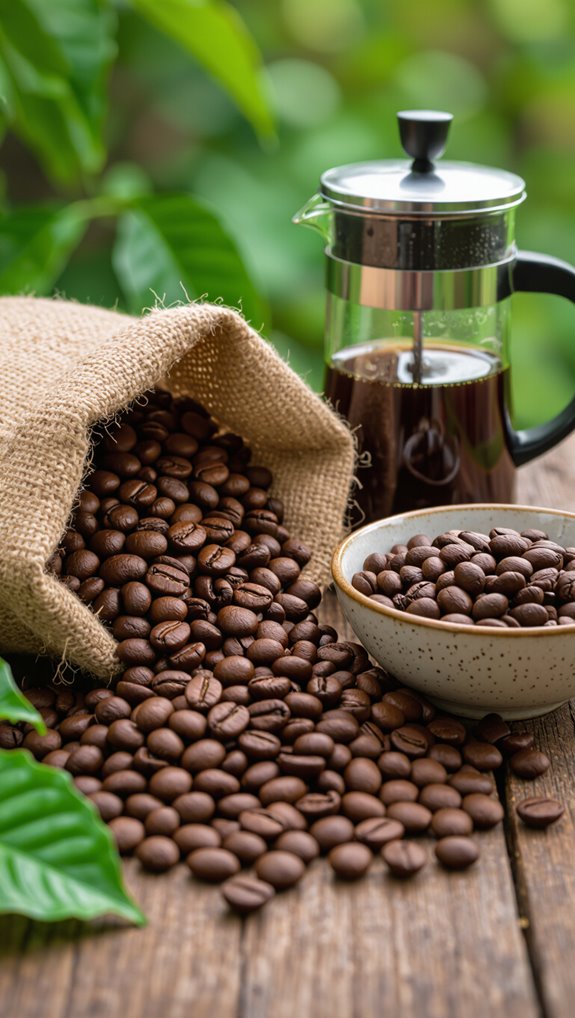
When comparing Tanzanian and Kenyan coffee beans, coffee enthusiasts will discover two distinct yet equally remarkable African coffee profiles that showcase the incredible diversity of East African terroir.
Tanzanian beans offer a balanced, medium to full-bodied experience with tropical fruit and chocolate notes, while Kenyan beans deliver a more intense, bright cup with sharp acidity and pronounced berry flavors.
Both originate from high-altitude volcanic regions, but differ subtly: Tanzania’s beans tend toward smooth, complex profiles, and Kenya’s toward vibrant, winey characteristics.
Their unique terroir and careful cultivation make each a prized specialty coffee.
Frequently Asked Questions
Is Tanzania Coffee Considered Organic and Fair Trade?
Yes, many Tanzanian coffee producers are certified organic and fair trade. I’ve seen how these certifications help farmers access premium markets, improve sustainability practices, and ensure better social and environmental standards for their coffee.
How Much Caffeine Do Tanzania Coffee Beans Contain?
I’ll tell you that Tanzania coffee beans typically contain 1.2% to 1.5% caffeine by weight. A standard six-ounce cup of Tanzanian Arabica coffee will deliver around 95-200 mg of caffeine, depending on brewing method.
Can I Roast Tanzania Coffee Beans at Home?
Yes, I can roast Tanzanian coffee beans at home! I’ll use an oven or stovetop, carefully monitor temperature, listen for cracking sounds, and aim for light to medium roasts that highlight the beans’ unique fruity and complex flavor profile.
What Is the Average Price of Tanzania Coffee?
Based on the background data, I’ll tell you that Tanzania coffee averages between US$ 2.45 and US$ 4.41 per kilogram at retail, with wholesale prices ranging from US$ 1.71 to US$ 3.08 per kilogram, depending on quality and market conditions.
Are Tanzania Coffee Farms Environmentally Sustainable?
Based on the background, Tanzania’s coffee farms are partially sustainable. They’re making progress with agroforestry, organic methods, and climate-resilient practices, but challenges remain, like significant tree cover loss and the need for widespread sustainable farming adoption.
In Conclusion
Tanzania coffee offers a sensory journey through volcanic landscapes, delivering an extraordinary taste experience that ranges from bright, wine-like acidity to deep chocolatey undertones. These beans represent more than just a drink—they’re a cultural narrative connecting you to the lush Kilimanjaro slopes and generations of dedicated farmers who’ve perfected their craft.
Whether you’re exploring what makes Tanzania coffee special or simply seeking your next favorite origin, the key lies in proper brewing. From pour-over to cold brew, each method can highlight different aspects of these complex beans. To truly unlock their potential, having the right equipment makes all the difference.
Ready to experience Tanzania coffee at its best? Check out our coffee machine reviews to find smart, well-reviewed options that’ll help you extract every nuanced flavor from these exceptional beans. The right brewer paired with quality Tanzania coffee creates an unmatched cup that honors the bean’s remarkable journey from farm to your mug.


